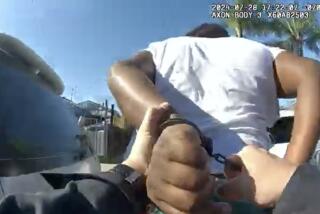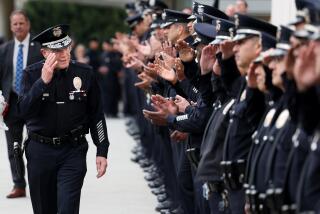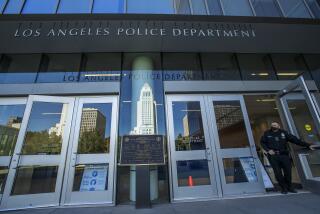Editorial: Has the LAPD changed enough since the Watts riots?
It’s tempting to look at recent headlines about unarmed African Americans dying at the hands of police officers and conclude that little has changed since 1965, when a traffic stop and the arrest of Marquette Frye triggered what became known as the Watts riots. Six days of mayhem from Aug. 11-17, primarily in South Los Angeles, left 34 people dead — most of them killed by police or the National Guard — millions of dollars in damage and a city trying to figure out what went wrong.
Then-Police Chief William H. Parker chalked it up to a few anti-police types who incited the community. If his department had any culpability, he said, it was for treating the black community with “kid gloves.” A commission convened to examine the root causes of the unrest found that a lack of jobs and education were the biggest factors. Members of the African American community, however, traced the unrest to years of discrimination and overpolicing by the Los Angeles Police Department.
------------
FOR THE RECORD
LAPD: An Aug. 12 editorial about the Los Angeles Police Department said that under Chief William H. Parker, black officers weren’t allowed to work outside of the Newton Division. While many African American officers were restricted to assignments in that division during the early part of Parker’s tenure, some did serve in other divisions.
------------
Despite the disparity of opinion, the white power structure of the city, including the Los Angeles Times’ editorial board, acknowledged that police needed to improve their relationship with “the Negro community.” What followed were 50 years of various reform efforts — some substantive, others little more than window dressing. And some done only after a second major civil disturbance 27 years later. They included community policing programs, anti-bias training, ethnic diversification of the force and even a federal consent decree.
There’s no question the LAPD is a substantially different department from Parker’s day, when black officers weren’t allowed to work outside of the Newton Division and couldn’t rise above the rank of lieutenant. Some of the changes are deliberate; some reflect shifts in demographics. America is similarly transformed. Consider how unlikely it would have been in 1965 for the shooting deaths of black men by police to inspire a national discussion about racism.
But one thing hasn’t changed, and that’s a sense among some that LAPD officers are too quick to use excessive force against men of color. That was one of the messages from protesters who disrupted the Police Commission meeting Tuesday to mark the first anniversary of the death of Ezell Ford, an unarmed and mentally ill African American man killed by police in South L.A.
The deaths of Ford, Michael Brown in Ferguson, Mo., and others in the last year during confrontations with police show that there’s still work to be done, by the LAPD and other departments across the country, to build trust in all the communities they serve.
Maybe it’s time for another ad hoc commission on policing — not to look at where we have been but to chart a course for where we need to go over the next 50 years.
Follow the Opinion section on Twitter @latimesopinion and Facebook
More to Read
A cure for the common opinion
Get thought-provoking perspectives with our weekly newsletter.
You may occasionally receive promotional content from the Los Angeles Times.










